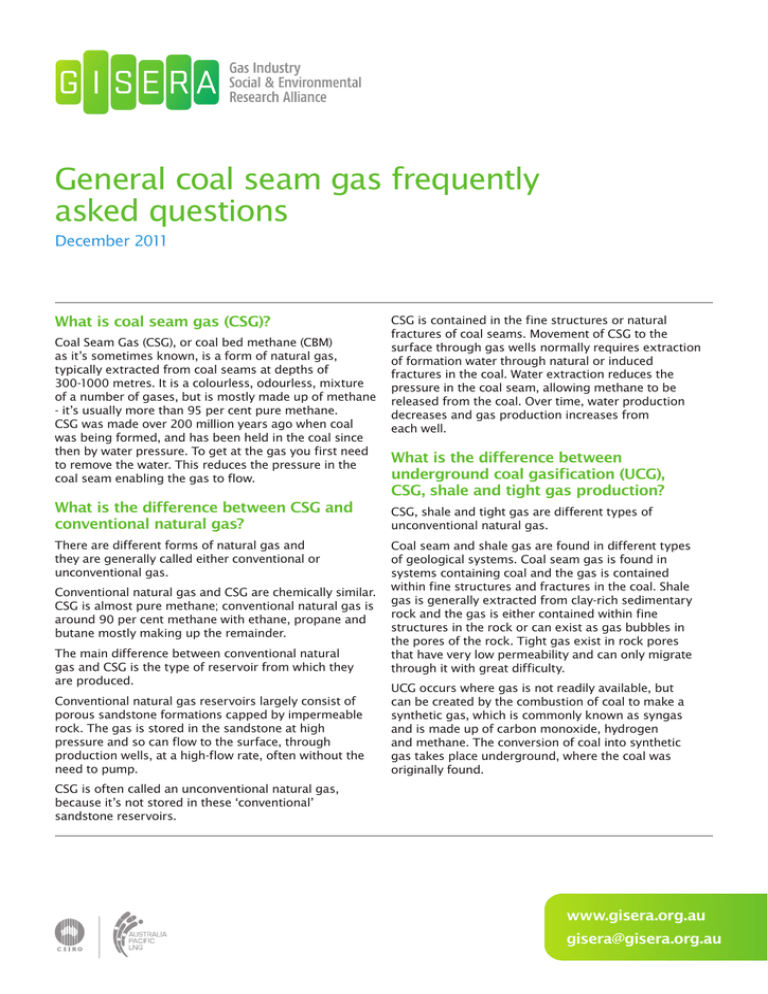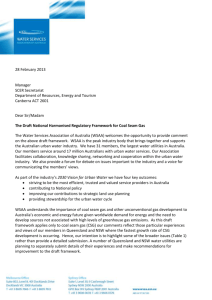General coal seam gas frequently asked questions
advertisement

General coal seam gas frequently asked questions December 2011 What is coal seam gas (CSG)? Coal Seam Gas (CSG), or coal bed methane (CBM) as it’s sometimes known, is a form of natural gas, typically extracted from coal seams at depths of 300‑1000 metres. It is a colourless, odourless, mixture of a number of gases, but is mostly made up of methane - it’s usually more than 95 per cent pure methane. CSG was made over 200 million years ago when coal was being formed, and has been held in the coal since then by water pressure. To get at the gas you first need to remove the water. This reduces the pressure in the coal seam enabling the gas to flow. What is the difference between CSG and conventional natural gas? There are different forms of natural gas and they are generally called either conventional or unconventional gas. Conventional natural gas and CSG are chemically similar. CSG is almost pure methane; conventional natural gas is around 90 per cent methane with ethane, propane and butane mostly making up the remainder. The main difference between conventional natural gas and CSG is the type of reservoir from which they are produced. Conventional natural gas reservoirs largely consist of porous sandstone formations capped by impermeable rock. The gas is stored in the sandstone at high pressure and so can flow to the surface, through production wells, at a high-flow rate, often without the need to pump. CSG is contained in the fine structures or natural fractures of coal seams. Movement of CSG to the surface through gas wells normally requires extraction of formation water through natural or induced fractures in the coal. Water extraction reduces the pressure in the coal seam, allowing methane to be released from the coal. Over time, water production decreases and gas production increases from each well. What is the difference between underground coal gasification (UCG), CSG, shale and tight gas production? CSG, shale and tight gas are different types of unconventional natural gas. Coal seam and shale gas are found in different types of geological systems. Coal seam gas is found in systems containing coal and the gas is contained within fine structures and fractures in the coal. Shale gas is generally extracted from clay-rich sedimentary rock and the gas is either contained within fine structures in the rock or can exist as gas bubbles in the pores of the rock. Tight gas exist in rock pores that have very low permeability and can only migrate through it with great difficulty. UCG occurs where gas is not readily available, but can be created by the combustion of coal to make a synthetic gas, which is commonly known as syngas and is made up of carbon monoxide, hydrogen and methane. The conversion of coal into synthetic gas takes place underground, where the coal was originally found. CSG is often called an unconventional natural gas, because it’s not stored in these ‘conventional’ sandstone reservoirs. www.gisera.org.au gisera@gisera.org.au What can CSG be used for? Is CSG a cleaner fuel source? Similarly to natural gas, CSG can be used in household stoves, heaters and hot water systems. It can also be used for industrial processes and for electricity generation. To date, the best available data on the greenhouse gas (GHG) footprint of CSG suggests that is likely to be a less GHG-intensive source of energy for electricity production than coal, by approximately 15-50 per cent. In other words, it’s estimated that for a given amount of electricity production, CSG will create approximately 15‑50 per cent less GHG emissions than coal. Specifically: •Coal seam gas accounts for almost 10 per cent (9 per cent) of Australia’s gas production, and is used to generate about 6 per cent of Australia’s electricity. •In Queensland, 90 per cent of the gas used in homes and industry is coal seam gas, and over 25 per cent of Queensland’s electricity is generated using coal seam gas. •Queensland’s production of CSG first exceeded that of conventional natural gas in 2002 – it’s now ten times that of conventional natural gas. It is important to note that these data are based on comparative studies, not direct measurements. Direct measurements are useful because the GHG footprint from gas or coal depends on the particulars of each individual resource asset, the way that it’s managed and the final use of the fuel. A greater understanding of the situation for Australia requires further research. •CSG has been a growing part of the nation’s energy supplies since 1996. •It’s estimated that up to 80 per cent of Queensland’s coal seam gas may be exported, where it’s most likely to be used to generate electricity. How much CSG is there? Australia in general and Queensland in particular has large reserves of coal seam gas. The known reserves keep growing because the more you look the more you tend to find. Proven and probable reserves comprise 28,000 PJ. That’s enough to meet Queensland’s existing electricity needs for about 50 years. The possible reserves may be as great as 300,000 PJ. That’s enough to meet all of Queensland’s current electricity generation needs for 500 years, or those of Australia for about 120 years. www.gisera.org.au gisera@gisera.org.au



